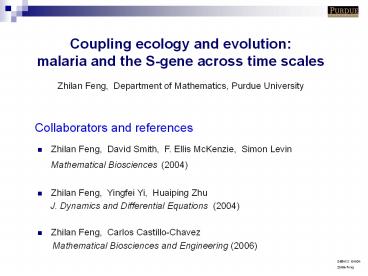Collaborators and references - PowerPoint PPT Presentation
Title:
Collaborators and references
Description:
Zhilan Feng, David Smith, F. Ellis McKenzie, Simon Levin Mathematical Biosciences (2004) ... However, possession of the sickle-cell gene leads to longer-lasting ... – PowerPoint PPT presentation
Number of Views:89
Avg rating:3.0/5.0
Title: Collaborators and references
1
Collaborators and references
Coupling ecology and evolution malaria and the
S-gene across time scalesZhilan Feng,
Department of Mathematics, Purdue University
- Zhilan Feng, David Smith, F. Ellis McKenzie,
Simon Levin Mathematical Biosciences (2004) - Zhilan Feng, Yingfei Yi, Huaiping Zhu
- J. Dynamics and Differential Equations
(2004) - Zhilan Feng, Carlos Castillo-Chavez
- Mathematical Biosciences and Engineering
(2006)
2
Outline
- Malaria epidemiology and the sickle-cell gene
- An endemic model of malaria without genetics
- A population genetics model without epidemics
- A model coupling epidemics and S-gene dynamics
- Analysis of the model
- Discussion
3
Malaria and the sickle-cell gene
- Malaria has long been a scourge to humans. The
exceptionally high mortality - in some regions has led to strong selection
for resistance, even at the cost of - increased risk of potentially fatal red blood
cell deformities in some offspring. - Genes that confer resistance to malaria when
they appear in heterozygous - individuals are known to lead to sickle-cell
anemia, or other blood diseases, - when they appear in homozygous form.
- Thus, there is balancing selection against the
evolution of resistance, with the - strength of that selection dependent upon
malaria prevalence. - Over longer time scales, the increased frequency
of resistance may decrease - the prevalence of malaria and reduce
selection for resistance - However, possession of the sickle-cell gene
leads to longer-lasting - parasitaemia in heterozygote individuals, and
therefore the presence of - resistance may actually increase infection
prevalence - We explore the interplay among these processes,
operating over very different
4
A simple SIS model with a vector (mosquito)
(1)
- b(N) growth rate of hosts
- bh infection rate of hosts
- bm infection rate of mosquitoes
- g recovery rate of hosts
- a malaria-related death rate
- mh per capita natural death rate of hosts
- mm infection rate of mosquitoes
S susceptible hosts I infected hosts
NSI total number of hosts z fraction of
infected mosquitoes
5
Dynamics of system (1)
6
A simple model of population genetics
(2)
7
Dynamics of system (2)
Note from the equation for the a gene
Thus, the gene frequency q converges to zero.
8
A model coupling dynamics of malaria and the
S-gene
(3)
i 1, 2 (AA, Aa)
9
Analysis of model (3)
Introduce fractions
( i 1,2 )
Note that
Then system (3) is equivalent to
A measure of S-gene frequency
(4)
10
Fast and slow time scales
Note b, mi , ai are on the order of 1/decades
bhi , bi , gmi , mm are on the order
of 1/days Rescale the parameters e gt 0 is
small
11
Separation of fast and slow dynamics
Then system (4) w.r.t. the fast time variables
(5)
and w.r.t. the slow time variables (Andreasen and
Christiansen, 1993)
(6)
12
Geometric theory of singular perturbations
N. Fenichel. Geometric singular perturbation
theory for ordinary differential equations
Let
be a set of stable equilibria of (5) with e0.
Then in terms of (6) M is a 2-D slow
manifold. The slow dynamics on M is described by
(7)
If the slow dynamics of (7) can be characterized
via bifurcations, then the bifurcating dynamics
on M are structurally stable hence robust to
perturbations
13
Malaria disease dynamics on the fast time scale
The reproductive number of malaria is
On the fast time-scale, if R0 gt 1 then all
solutions are hyperbolically asymptotic to
the endemic equilibrium Em (y1, y2, z)
where
and z gt 0 is a solution to a quadratic equation
with ki
14
S-gene dynamics on the slow time scale
where
- Fitness F s1 - s2 determines
- The slow dynamics
Bi-stable equilibria possible
15
Possible equilibria of the slow system
N
N
H1
(1,K)
(1,K)
H1
H2
H2
0
w
0
w
1
1
w
w1
w2
16
Global dynamics of the slow manifold
- The slow system (7) has no periodic solution or
homoclinic orbit.
Suppose there is a closed orbit around
E(w,N). Construct Q1(w), Q2(N) and
Q(w,N)Q1Q2 as
Note that
and
Contradiction
2
Q(w,N)
0
-2
(w, N)
0
N
2000
w
17
S-gene dynamics on the slow time scale
Bistability
18
Effect of S-gene dynamics on malaria prevalence
w S-gene frequency 1/gi Infectious period
Possession of the S-gene leads to longer-lasting
parasitaemia (1/g2) in heterozygote individuals,
and therefore the presence of resistance may
actually increase infection prevalence
19
Influence of malaria on population genetics
A balancing selection against the evolution of
resistance, with the strength of selection
dependent upon malaria prevalence.
n Death due to S-gene ai Death due to
malaria Wi Malaria parameters
20
Conclusion
- By coupling malaria epidemics and the S-gene
dynamics, our model allows - for a joint investigation of
- influence of malaria on population genetic
composition - effect of the S-gene dynamics on the prevalence
of malaria, and - coevolution of host and parasite
- These results cannot be obtained from
epidemiology models without - genetics or genetic models without epidemics.
21
Acknowledgements
- National Science Foundation
- Jams S. McDonnell Foundation































